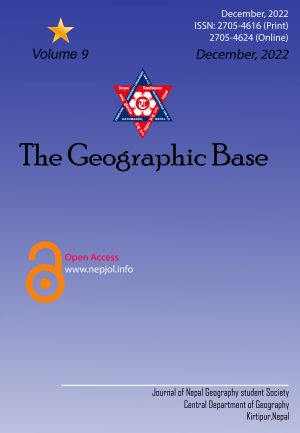Impact of Climate Induced Disaster in Sindhupalchowk District
DOI:
https://doi.org/10.3126/tgb.v9i1.55442Keywords:
Disaster, Hazard, Climate, Loss and damage, SindhupalchowkAbstract
This study attempt to analyze the impact of climate induced disaster on human, private housing, government building, and economy in Sindhupalchowk district based on the information available on Nepal Disaster Risk Reduction Portal from 1971 to 2022. The disaster caused by climate change can be classified as hydrological, climatological, meteorological, or both. Hydrological disasters are controlled by hydrological processes, such as floods, droughts, and avalanches; climatological disasters are concerned with hazards related to extreme temperatures, such as heat waves, cold waves, and wildfires; and meteorological disasters represent storms of all types, such as snowstorms, thunderstorms, hurricanes, and tornadoes. This article is based on literature review that includes district disaster preparedness and response plan (DPRP) and different articles related to disaster and climate induced disaster. DRR portal of MoHA and Disinventar are the major secondary source of information. Sindhuplchowk district is one of the disaster-prone districts of Nepal. Landslide, flood and thunderbolt are the major disasters of Sindhupalchowk district. Climate induced disaster affected 100,903 families; 4,467 persons have lost their lives, 2,778 to have been injured, 314 missing. It has found that among all disaster 53% death toll by climate induced disaster and 47% death happens due to the non-climate induced disaster. Damage and losses due to the disaster were amounted to an estimated 72,565,001 Nepalese rupees. The findings of this study can help local, national, and international policies and decision-making in order to lessen the risks associated with these disasters and foster resilient communities.
Downloads
Downloads
Published
How to Cite
Issue
Section
License
© Nepal Geography Student Society




